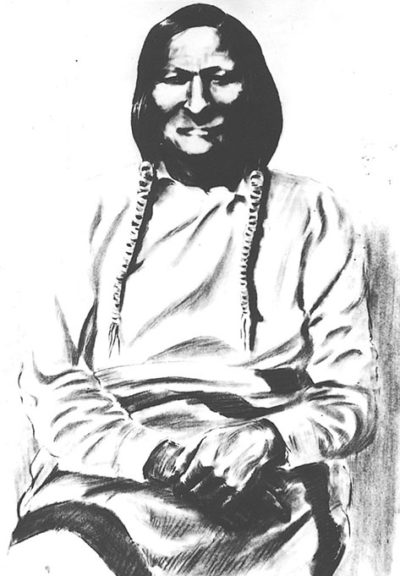Black Kettle (Black Kettle)

Little is known of chief Black Kettle’s life prior to 1854, when he was made a chief of the Council of Forty-four, the central government of the Cheyenne tribe. The Council met regularly at the Sun Dance gatherings, where they affirmed unity. After 1850, Cheyenne-US relations were conducted under the Treaty of Fort Laramie. But, the US government was unwilling to control white expansion into the Great Plains, especially after the Pike’s Peak Gold Rush began in 1859. European Americans displaced the Cheyenne from their lands in violation of the treaty, and consumed important resources of water and game. Increasing competition led to armed conflict between the groups. Black Kettle was a pragmatist who believed that US military power and the number of immigrants were overwhelming. In 1861 he and the Arapaho surrendered to the commander of Fort Lyon under the Treaty of Fort Wise, believing he could gain protection for his people. The treaty was highly unfavorable to the Southern Cheyenne. They led their bands to the Sand Creek Reservation, a small corner of southeastern Colorado about 40 miles from Fort Lyon. The land was not arable and was located far away from buffalo, their major source of meat. Many Cheyenne warriors, including the Dog Soldiers would not accept this treaty. They began to attack white settlers. Whether Black Kettle opposed these actions, tolerated them, or encouraged them is a controversy among historians.
By the summer of 1864, the situation was at boiling point. Southern Cheyenne hardliners, along with allied Kiowa and Arapaho bands, raided American settlements for livestock and supplies. Sometimes they took captives, generally only women and children, to adopt into their tribes to replace lost members. On 11 July 1864, Indians killed a family of settlers, an attack which the whites called the Hungate massacre after the family. Pro-war whites displayed the scalped bodies in Denver. Colorado governor John Evans believed tribal chiefs had ordered the attack and were intent on a full-scale war. Evans issued a proclamation ordering all “Friendly Indians of the Plains” to report to military posts or be considered “hostile.” He sought and gained from the War Department authorization to establish the Third Colorado Cavalry. John Chivington led the unit, composed of “100-daysers,” whose limited term was specifically for fighting against the Cheyenne and Arapaho. Black Kettle decided to accept Evans’ offer, and entered negotiations. On September 28, he concluded a peace settlement at Fort Weld outside Denver. The agreement assigned the Southern Cheyenne to the Sand Creek reservation and required them to report to Fort Lyon, formerly Fort Wise. Black Kettle believed the agreement would ensure the safety of his people. After he went to the reservation, the commanding officer at the fort was replaced by one who was an ally of Chivington.
At dawn on November 29, Chivington attacked the Sand Creek reservation. Most of the warriors were out hunting. Following Indian agent instructions, Black Kettle flew an American flag and a white flag from his tipi, but the signal was ignored. The Colorado forces killed 163 Cheyenne by shooting or stabbing. They burned down the village encampment. Most of the victims were women and children. For months afterward, members of the militia displayed trophies in Denver of their battle, including body parts they had taken for souvenirs. Black Kettle escaped the massacre, and returned to rescue his severely injured wife who suffered 9 bullet and shrapnel wounds. He continued to counsel pacifism, believing that military resistance was doomed to fail. The majority of the Southern Cheyenne chiefs disagreed. Allied with the Comanche and Kiowa, they went to war against US settler and forces. Black Kettle moved south and continued to negotiate with US officials. He achieved the Treaty of Little Arkansas River on October 14, 1865. By this document, the US promised “perpetual peace” and lands in reparation for the Sand Creek massacre. However, its practical effect was to dispossess the Cheyenne yet again and require them to move to Indian Territory (present-day Oklahoma). Black Kettle’s influence continued to wane. Roman Nose and his Dog Soldiers took a prevailing hard line and continued warfare.
Black Kettle’s dwindling band proclaimed their desire to live peacefully alongside European Americans. Black Kettle signed yet another treaty, the Medicine Lodge Treaty on October 28, 1867. But, the Dog Soldiers continued their raids and ambushes across Kansas, Texas, and Colorado. The relationship between the two groups is a subject of historical dispute. According to Little Rock, second-in-command of Black Kettle’s village, most of the warriors came back to Black Kettle’s camp after their attacks. White prisoners, including children, were held within his encampment. By this time Black Kettle’s influence was waning, and it is unclear whether he could have stopped the younger warriors’ actions. In response to the continued raids and massacres, General Philip Sheridan devised a plan of punitive reprisals. He planned to attack Cheyenne winter encampments, destroying both supplies and livestock, and killing any people who resisted. At dawn on the morning of November 27, 1868 (ironically one day short of the 4 year anniversary of The Sand Creek Massacre), George Armstrong Custer led troops to attack Chief Black Kettle and his village. They were camped along the Washita River. Custer’s troops killed more than 100 Native Americans, mostly Southern Cheyenne. While trying to cross the Washita River, Black Kettle and his wife were shot in the back and killed. According to Cheyenne oral tradition, a survivor of Washita was Black Kettle’s daughter Meotzi/Monahseetah (Mo-nah-se-tah) who had a son, Yellow Swallow by Custer, although in fact Mo-nah-se-tah was the daughter of Little Rock (Cheyenne chief) and not Black Kettle.
Born
- January, 01, 1803
- USA
- Black Hills
Died
- November, 27, 1868
- USA
- Washita, Oklahoma
Cemetery
- Black Kettle Museum
- Cheyenne, Oklahoma
- USA

